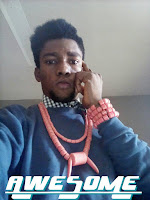'Penny Dreadful' Is Back And Still Highly Addictive
Before I get to the reasons you should watch the second season of Showtime's "Penny Dreadful," a recommendation: Watch the show's bracing first season.
It's not a binge that requires an excessive amount of time. Season 1, which ended up on my 2014 Top 10 list, is a mere eight hours long, and this year's batch of episodes will be even more rich and entertaining if you know the histories of the players in the game.
Though it shares a time frame and often a hothouse atmosphere with classic Sherlock Holmes tales, "Penny Dreadful" is not exactly a mystery, but it's definitely the kind of show in which I can easily imagine a character declaring, "The game's afoot!" "Penny Dreadful" gleefully owns what it is and glories in its energetic theatricality. More than once in the first couple of episodes, it shows the exterior of a Victorian mansion on a dark and stormy night. Lightning flashes over the gloomy gables, of course, and curious creatures reside therein.
These kinds of moments aren't just operatic scene-setters, they're knowing winks to the kind of supercharged Victorian genre literature that gives the show its name. But it would be wrong to imply that "Penny Dreadful" is mainly interested in flash and operatic visuals, as diverting as those things are.
As colorful and meta-aware as "Penny Dreadful" often is, its real business is much more emotionally acute and heartfelt than initial impressions might indicate. If you do dive into Season 1, know that the bloody moments of the early part of the season largely recede so that a much more tangled story of betrayal, affection and regret comes to the fore. The show ended up on my Top 10 list not because it featured blood and freakish beasties, but because it made me cry.
"Penny Dreadful" is an
entertainment
It's also a showcase for a cast that is so uniformly wonderful that I hate to single out any actors in particular, but this season especially, I must. I've written about how tremendous Eva Green is in the role of Vanessa Ives; she's able to inject her considerable charisma into big, theatrical moments and still find telling emotional details in subtler scenes. It's a career-making performance, and I simply cannot wait to see her go head to head with the season's most notable cast addition (more on that below).
One of the most fun elements of Season 2 is the way Logan is now writing to the various strengths of each actor: Josh Hartnett, who plays an American adventurer in London, proved he could do fabulous things in tender moments and also take charge of big set pieces, and this season, he even gets to crack a small joke or two. Timothy Dalton, as explorer Malcolm Murray, anchors the show beautifully and his eyes tell a story in every scene. Dalton is a pro who is clearly having fun with a role that takes full advantage of his canny presence, which can be both commanding and sly, and yet Dalton never lets us forget the tragedies that nearly broke the brave but arrogant Murray.
The big news of Season 2 is the addition of Helen McCrory to the regular cast. Her character, Madame Kali, popped up in a couple of episodes in Season 1, and as Logan explained in an interview, he introduced her character knowing he had much bigger plans for her this season. I'm a little bit annoyed with everyone in the U.K. for not sharing McCrory with us Yanks much more frequently (same goes for "Happy Valley's" Sarah Lancashire, who is also a treasure).
But never mind: McCrory is phenomenal in the Netflix series "Peaky Blinders," and she's similarly bewitching here. This is a bold show that needs brave, mesmerizing actors to carry it, and McCrory is clearly capable of bending every deliciously written scene to her considerable will. She too appears to be having a blast with her mysterious, scheming character, who, believe it or not, is up to no good.
Bombast, saturated palettes and grandiosity are not necessarily prized on the TV landscape today, and it's easy to understand why: These are easily abused and misused elements (see also "American Horror Story," which disappoints more often than it succeeds and thus its self-congratulatory "bravery" typically curdles into self-indulgence). Most of the Prestige TV of the aughts and beyond has acted as a corrective of sorts to the kind of overly obvious and often loud programs that TV inflicted on viewers for a long time. In the past decade or two, stories of complex characters usually leaned on various kinds of restrained, calculating formality. I'm guessing the reasoning often went like this: If the characters are ambiguous, that's even more reason for the art to be precise.
The achievement of "Penny Dreadful" is that within its highly stylized, delightfully elaborate and occasionally batsh-t world, it has created complex, fascinating characters -- or rather, it has begun to. It somehow manages to be an escapist pleasure full of Dickensian interiors and lush paeans to pleasure and gore, and also a deliberately calibrated character drama, as well. It can be loud, it can be cheeky, it has fun with what it is, but underneath all the velvet and fringe, there is a beating heart -- sometimes where you least expect it.



Comments
Post a Comment